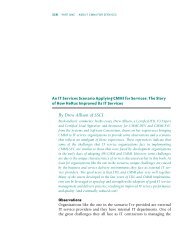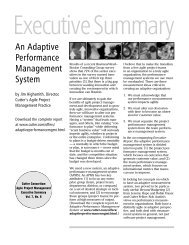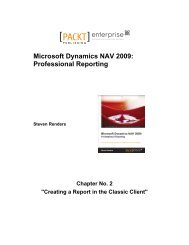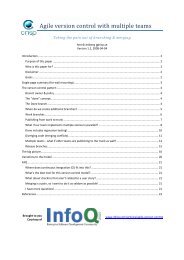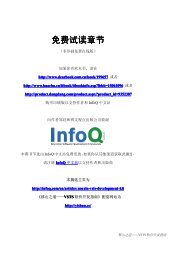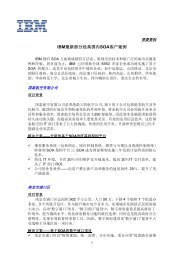PREFACE
PREFACE
PREFACE
Create successful ePaper yourself
Turn your PDF publications into a flip-book with our unique Google optimized e-Paper software.
<strong>PREFACE</strong><br />
Denning f02.tex V3 - 08/02/2010 11:15am Page v<br />
’’<br />
the return on assets for U.S.<br />
firms has steadily fallen to almost one<br />
quarter of 1965 levels ...very few<br />
‘‘Remarkably,<br />
[workers] (20 percent) are passionate<br />
abouttheirjobs...executive turnover<br />
is increasing. Consumers are becoming<br />
less loyal to brands ...the rate at which<br />
big companies lose their leadership<br />
positions is increasing.<br />
Deloitte Center for the Edge 1<br />
Total Attorneys is a rapidly growing Chicago-based company that provides<br />
services and software to small law firms. As a start-up in 2002, it was highly<br />
energized: work was done on the fly, new products were developed, new<br />
markets opened, and new customers were identified. But as the firm grew,<br />
so did bureaucracy. Departments were formed, processes and structures<br />
were put in place, work slowed down, and the staff morale deteriorated.<br />
In some cases, Total Attorneys moved so slowly that by the time its<br />
software was completed, the client wanted something different. By 2008,<br />
with around 160 employees, Total Attorneys was still making money, but<br />
it had gone from being an exciting place to work to a bureaucratic logjam.<br />
Up to this point, Total Attorneys was a depressingly familiar story.<br />
But Total Attorney’s CEO, Ed Scanlan, began asking himself: ‘‘Why were<br />
we able to get more done in forty-five days with three guys than I had just<br />
v
Preface<br />
Denning f02.tex V3 - 08/02/2010 11:15am Page vi<br />
accomplished in the last six months with several departments? Why are<br />
our tires stuck in the mud?’’<br />
So Scanlan decided to change the story and recapture some of the<br />
start-up energy and excitement. He replaced departmental silos with<br />
small cross-functional teams that themselves decided how to do the work<br />
and even how much work to do. The teams began working in cycles,<br />
implementing a prioritized series of tasks that reflected what clients<br />
wanted to see developed. At the end of each cycle, the work was demonstrated<br />
to clients, and their feedback was incorporated in the next cycle. In<br />
this way, the work was always focused on tasks of high priority to clients.<br />
Scanlan started the approach with the software developers, but it was<br />
so successful there that he soon extended it to the call centers. For instance,<br />
the eighty-five call center employees were divided into fifteen teams and<br />
colocated on the same floor as the software developers to enhance direct<br />
communication.<br />
More recently, the approach has spread spontaneously to sales,<br />
marketing, accounting and the general counsel’s office. Now the whole<br />
firm is buzzing with energy and excitement and laughter again.<br />
‘‘This way of managing appeals particularly to the new generation,’’<br />
says Scanlan. ‘‘They want autonomy. They want ownership. They want<br />
purpose. It makes sense to them. But it also resonates with older workers.’’<br />
Many firms are now discovering what Total Attorneys discovered: that<br />
a revolutionary way of organizing and managing work is emerging that can<br />
generate continuous innovation, deep job satisfaction, and client delight.<br />
It is very different from the practices of traditional management: hierarchy,<br />
command and control, tightly planned work, competition through<br />
economies of scale and cost reduction, and impersonal communications.<br />
Traditional management practices, which continue to be taught in<br />
business schools and described in management textbooks, worked well<br />
enough for much of the twentieth century but are a poor fit for today’s<br />
economic context.<br />
Thesignsofthemisfitarewidespread.Therateofreturnonassets<br />
keeps on its decades-long decline. Innovation continues to falter. Workers<br />
vi
Preface<br />
Denning f02.tex V3 - 08/02/2010 11:15am Page vii<br />
are disgruntled. Customers are frustrated. Brands are unraveling. Reorganizations,<br />
downsizings, and outsourcings proliferate. Executive turnover<br />
is accelerating. Institutional life expectancies are less than two decades. In<br />
the past twenty-five years, start-ups created 40 million jobs in the United<br />
States, while established firms created almost none. 2<br />
Early in 2008, I set out to understand the source of these problems<br />
and to discover what could be done about them. This book tells the story<br />
of that journey.<br />
There must be workplaces, I thought, where work is highly productive,<br />
new ideas are embraced, and jobs are deeply satisfying. Could the<br />
conditions that had enabled that to happen be identified? Could those conditions<br />
be reverse-engineered? Is it possible to create an environment that<br />
was congenial to ideas that are vibrant, exciting, or different, in a sustained<br />
way, not just in isolated cases?<br />
I began by asking people if they knew about any such workplaces. My<br />
expectation was that finding them would be difficult—like searching for<br />
a needle in a haystack. Few people would know about them, I thought, let<br />
alone have personal experience of them.<br />
My first surprise was that I had no difficulty at all in finding them. In<br />
fact, almost everyone I talked to could tell me about an experience that<br />
they had, although typically it wasn’t in their current workplace.<br />
The second surprise came when I noticed that an unusually high<br />
proportion of these extraordinary experiences had been in software<br />
development. Initially I didn’t pay this any attention. After all, these were<br />
geeks, and they talked with a strange vocabulary. What could I possibly<br />
learn about management from people who had, I imagined, gone into<br />
computing because they preferred machines to people?<br />
My third surprise was what was going on in these companies. When<br />
I checked it out, I discovered a way of managing that was much more<br />
productive than traditional management and where the people doing the<br />
work were having serious fun. 3<br />
Thefourthsurprisewasthatitwasn’tlimitedtosoftwaredevelopment.<br />
Once this different way of managing got under way in one part of the<br />
vii
Preface<br />
Denning f02.tex V3 - 08/02/2010 11:15am Page viii<br />
company, it tended to spread to other parts of the company, even the<br />
entire firm. It was also widespread in some parts of auto manufacture and<br />
in successful start-ups. In fact, once I understood the principles, I started<br />
to see signs of it in many different sectors.<br />
The final big surprise was that when I joined the dots and fully<br />
understood the elements, I realized that what I had stumbled on was more<br />
than a management technique. The idea was larger, with far-reaching<br />
economic, social, and ethical implications.<br />
Overall, this was very different from the way most companies are<br />
currently run. As Mikkel Harbo, director of business development and<br />
operations at the Danish company Systematic Software told me, ‘‘Once<br />
you introduce this, it affects everything in the organization—the way you<br />
plan, the way you manage, the way you work. Everything is different. It<br />
changes the game fundamentally.’’<br />
It is for this reason that I call it radical management. 4 It goes to the<br />
root of what makes things happen in the world. The workplaces that it<br />
creates are drastically different from traditional management. It implies<br />
fundamental shifts in how we think, speak, and act at work.<br />
In this book, I am inviting you to take the journey that I have<br />
taken and learn what I have learned. It will mean spending time to<br />
think about what we are doing in organizations today and why. It will<br />
entail considering what kinds of organizations we want to create, as<br />
well as imagining why and how they could be very different from most<br />
organizations today—providing work that is much more productive and<br />
much more satisfying.<br />
This book doesn’t offer a quick fix, because the nature and scale of the<br />
issues that we are dealing with in today’s workplaces are not susceptible<br />
to a quick fix.<br />
Nor is this a book about what’s new, even though that is an eternally<br />
intriguing topic. When pursued exclusively, it results in a preoccupation<br />
with fads and trivia.<br />
In this book, I am concerned with the questions: What is good? and<br />
Whom is it good for? Is it good for the organization? Is it good for those<br />
viii
Preface<br />
Denning f02.tex V3 - 08/02/2010 11:15am Page ix<br />
doing the work? Is it good for those for whom the work is done? Is it good<br />
for society at large? These are questions that cut deeply. They involve<br />
examining: What is true productivity for an organization? What is its<br />
source? What is needed to sustain it? What is responsibility? What does<br />
it mean to be genuinely authentic? What lifts up the human spirit and<br />
makes it sing?<br />
The principles I describe in this book constitute a radical change from<br />
the way most organizations are currently managed. Standard managerial<br />
practices today systematically lead to organizational underperformance,<br />
disgruntled workers, and frustrated customers. Most proposals for reforming<br />
management advance one of those elements at the expense of the other<br />
two. The principles set out in this book magnify human capacity and<br />
simultaneously inspire high productivity, continuous innovation, deep<br />
job satisfaction, and client delight.<br />
August 2010 Stephen Denning<br />
Washington, D.C.<br />
ix
Denning f02.tex V3 - 08/02/2010 11:15am Page x
INTRODUCTION<br />
Denning c00.tex V2 - 07/20/2010 11:12am Page 1<br />
’’<br />
a factory is torn down but the rationality<br />
which produced it is left standing, then<br />
that rationality will simply produce<br />
‘‘If<br />
another factory.<br />
Robert Pirsig1 This is a book about a radically different way of managing. It’s about<br />
pulling apart the black box of traditional management and putting the<br />
pieces together in a way that creates continuous innovation and client<br />
delight. It involves a wholly different way of thinking, speaking, and acting<br />
at work. It leads to workplaces that are more productive and more fun.<br />
These workplaces feel different.<br />
Given the deep change that has taken place in both the marketplace<br />
and the workplace, should we be surprised that we need different<br />
management today?<br />
THE MARKETPLACE HAS CHANGED<br />
In the marketplace, what worked yesterday—satisfying customers by<br />
offering average products or services with zero defects—is no longer good<br />
enough. Absence of defects is expected and lacks luster. Unless clients are<br />
delighted, they can—and will—go elsewhere. The bar has been raised.<br />
To ensure long-term growth, firms must forge relationships with<br />
their customers and turn them into long-term supporters and advocates<br />
of the firm’s goods and services. They must continually find new and<br />
1
The Leader’s Guide to Radical Management<br />
Denning c00.tex V2 - 07/20/2010 11:12am Page 2<br />
economical ways to provide goods or services that are differentiated,<br />
noteworthy, surprising, or remarkable. They need constant innovation. 2<br />
Delighting clients goes beyond reconfiguring the marketing department.<br />
3 It means committing the entire organization, and everyone in it,<br />
to delighting clients as the firm’s principal goal and putting in place the<br />
management principles and practices needed to accomplish that goal.<br />
THE WORKPLACE HAS ALSO CHANGED<br />
‘‘Management was originally invented,’’ management theorist Gary Hamel<br />
has noted, ‘‘to solve two problems: the first—getting semiskilled employees<br />
to perform repetitive activities competently, diligently, and efficiently;<br />
the second—coordinating those efforts in ways that enabled complex<br />
goods and services to be produced in large quantities. In a nutshell, the<br />
problems were efficiency and scale, and the solution was bureaucracy, with<br />
its hierarchical structure, cascading goals, precise role definitions, and<br />
elaborate rules and procedures.’’ 4<br />
With the continuing shift from semiskilled work to what economists<br />
call knowledge work, hierarchical bureaucracy is no longer a good solution.<br />
Its consequences are well known. It results in the talents, ingenuity, and<br />
inspiration of the workforce not being fully tapped. Only one in five<br />
workers is fully engaged in his or her work. 5 For the organization,<br />
this means that the energies and insights of four out of five people in<br />
the workplace are being needlessly squandered. When the firm’s future<br />
depends on what knowledge workers can contribute, leaving talent unused<br />
becomes a serious productivity problem.<br />
For the customers of these organizations, the situation is similarly<br />
grim: a firm full of people who are not fully engaged in their work is not<br />
much fun to deal with. Although firms talk about customer service and<br />
responsiveness, they are more often engaged in one-way communications.<br />
The recorded message might say, ‘‘Your call is important to us,’’ but<br />
customersknowthatitisn’t.<br />
2
Introduction<br />
THE SYSTEM IS THE PROBLEM<br />
Denning c00.tex V2 - 07/20/2010 11:12am Page 3<br />
I argue in this book that the problems of today’s workplace are not<br />
the personal fault of the individual managers. They are largely the fault<br />
of the system they are implementing, which relentlessly constrains the<br />
capacity of people to contribute, limits the firm’s productivity, and<br />
practically guarantees that clients will be dissatisfied. The mental model<br />
of management that these companies are pursuing, with interlocking<br />
attitudes and practices, methodically prevents any individual management<br />
fix from permanently taking hold.<br />
In the chapters ahead, I introduce a very different way of managing.<br />
I offer one extraordinary example after another: software developers, car<br />
manufacturers, house builders, staff in a call center, and songwriters,<br />
among others. And I will show people having serious fun in their work<br />
and becoming steadily better at doing it.<br />
The emerging approach to managing is proving to be not only more<br />
productive than traditional management. It also liberates the energies,<br />
insights, and passions of people. It creates workplaces that enable the<br />
human spirit. It delights clients and creates shining eyes among the people<br />
doing the work.<br />
This is not about firms becoming more productive by having people<br />
work longer hours or by downsizing or outsourcing. It’s about deploying<br />
energies differently. In some areas, managers have to do more. In other<br />
areas, they need to do less. Overall they will have to act on the basis of principles<br />
that are quite different from those of today’s traditional managers.<br />
THE SEVEN PRINCIPLES OF RADICAL<br />
MANAGEMENT<br />
The seven principles I describe form a self-reinforcing sequence<br />
(Figure I.1). Radical management begins by getting the goal right: the<br />
purpose of work is to delight clients, not merely to produce goods or<br />
services or make money for shareholders (Principle #1).<br />
3
The Leader’s Guide to Radical Management<br />
FIGURE I.1 Radical Management: The Seven Basic Principles of<br />
Continuous Innovation<br />
Principle #7:<br />
Communicate<br />
interactively: stories, questions, conversations<br />
Principle #1:<br />
Focus work on delighting the client<br />
Principle #2:<br />
Do work through self-organizing teams<br />
Principle #3:<br />
Do work in client-driven iterations<br />
Principle #4:<br />
Deliver value to clients in each iteration<br />
Principle #5:<br />
Be totally open about impediments<br />
to improvement<br />
Principle #6:<br />
Create a context for continuous<br />
self-improvement by the team<br />
Continuous Innovation<br />
Denning c00.tex V2 - 07/20/2010 11:12am Page 4<br />
Focusing on client delight leads to self-organizing teams, because<br />
client delight requires continuous innovation, and a self-organizing team<br />
is the management arrangement most likely to generate continuous<br />
innovation (Principle #2).<br />
This leads to working in client-driven iterations, because delighting<br />
clients can be approached only by successive approximations. And selforganizing<br />
teams, being life forms that live on the edge of chaos, need<br />
checkpoints to see whether they are evolving positively or slipping over<br />
theedgeintochaos(Principle#3).<br />
Similarly, client-driven iterations focus on delivering value to clients<br />
by the end of each iteration. They force closure and enable frequent client<br />
feedback (Principle #4).<br />
4
Introduction<br />
Denning c00.tex V2 - 07/20/2010 11:12am Page 5<br />
Self-organizing teams that are working in an iterative fashion both<br />
enable and require radical transparency (Principle #5) so that the teams<br />
go on improving of their own accord (Principle #6).<br />
An underlying requirement of all of these principles is interactive<br />
communication (Principle #7). Unless managers and workers are communicating<br />
interactively, using authentic narratives, open-ended questions,<br />
and deep listening, rather than treating people as things to be manipulated,<br />
none of the other principles work.<br />
When self-organizing teams are set up and supported by implementing<br />
these principles, they naturally evolve into high-performance teams<br />
that are significantly more productive than the norm and deeply satisfying<br />
to workers.<br />
Together the principles constitute a radical shift in the practice of<br />
management and an approach that is well adapted to meet the challenges<br />
of the twenty-first-century organization.<br />
PRINCIPLES AND PRACTICES<br />
These principles comprise the seven most important elements of radical<br />
management. At the end of each chapter, I describe a large number of<br />
practices—more than seventy of them in total—that offer some of the<br />
ways to go about implementing the principles. Some practices support<br />
more than one principle.<br />
The principles are more fundamental than the practices. If you think<br />
about the principles enough, you should be able to deduce the practices<br />
from them. If you keep the seven principles steadily in mind, you shouldn’t<br />
go too far wrong.<br />
Thus, in implementation, it’s important to focus on the spirit of<br />
radical management and not get lost in the fine print. Even if you’re not<br />
doing all of the seventy-plus practices yet are living the seven principles,<br />
that’s still radical management. However, if you are doing lots of the<br />
practices but not living some of the principles, then you should probably<br />
ask yourself whether you still have at least one foot in the land of traditional<br />
management.<br />
5
The Leader’s Guide to Radical Management<br />
Denning c00.tex V2 - 07/20/2010 11:12am Page 6<br />
This is not a book about praising famous firms or the current media<br />
darlings. Instead I discuss how ordinary people become extraordinary<br />
and how every firm can continuously reinvent itself. Rather than talking<br />
about prodigies or celebrities, I describe a way of working that is broadly<br />
available to all.<br />
The organizations that I cite in the book have embarked on journeys.<br />
They are all at different stages of the journey, and none of them has in<br />
any permanent sense ‘‘arrived.’’ We will see more than one company<br />
that implemented the principles for a period and then lost its way.<br />
Implementing the principles requires constant energy and attention.<br />
I rarely use Japanese terms like kanban or kaizan, although Japanese<br />
firms have made an enormous contribution to management thinking and<br />
practice. My goal is to communicate certain truths that transcend any<br />
particular country or culture.<br />
I also make sparing use of the terminology that is widespread in<br />
software development, under the labels of ‘‘Agile’’ and ‘‘Scrum,’’ with<br />
terms like scrum-masters, product owners, burndown charts, and sprints.<br />
Software developers deserve credit for advancing some of the thinking<br />
described in this book to its fullest extent. Their terminologies were<br />
deliberately chosen to differentiate this way of developing software from<br />
the roles and practices of traditional management. 6 The terminology has<br />
been helpful in software development. My goal here is to explain in plain<br />
language how the underlying managerial principles and practices have<br />
roots in many different fields and apply to all sectors of the economy.<br />
Some critics will say that the principles and practices I describe are<br />
not possible, that they embody an unbelievable utopia, or that they have<br />
already been tried and shown not to work. They will give a thousand<br />
reasonsthatwehavenochoicebuttokeeponmanagingthewaywe<br />
always have, with stunted productivity, dispirited workers, and frustrated<br />
customers.<br />
It would be easier to accept that version of events if scores of organizations<br />
were not already practicing the principles of radical management<br />
and achieving extraordinary performance.<br />
6
This book is intended for:<br />
Introduction<br />
WHO THIS BOOK IS FOR<br />
Denning c00.tex V2 - 07/20/2010 11:12am Page 7<br />
Leaders and managers who want to reinvent the workplace and<br />
inspire extraordinary productivity, continuous innovation, deep job<br />
satisfaction, and client delight—all simultaneously<br />
Leaders and managers who want to lift their game and create organizations<br />
that buzz with extraordinary energy, excitement, innovation,<br />
and genuine high performance<br />
Leaders and managers who want to run established organizations<br />
with the energy and innovativeness of a start-up<br />
Anyone trying to understand how software developers practicing<br />
Scrum and Agile or manufacturers implementing lean production<br />
achieve extraordinary gains in productivity, and how to apply what<br />
they do to general management<br />
Anyone who wants to make leadership storytelling an integral part of<br />
the culture of an organization.<br />
In short, this book is intended for those who wish to enjoy a life filled<br />
with passion, excitement, and productivity and create that for others. This<br />
is about taking charge of your life and experiencing the spirit and the<br />
exhilaration of extraordinary performance.<br />
7
The Leader’s Guide to Radical Management<br />
Denning c00.tex V2 - 07/20/2010 11:12am Page 8<br />
THE DIFFERENCES BETWEEN TRADITIONAL<br />
AND RADICAL MANAGEMENT<br />
The differences between traditional management and radical management<br />
are stark. They flow from different goals. They involve different<br />
modalities. They have different consequences, as this table shows:<br />
Traditional Management Radical Management<br />
Goal The purpose of work is to<br />
produce goods or services.<br />
How work is<br />
organized<br />
Work is done by individuals<br />
reporting to bosses.<br />
Plan Work is done in accordance<br />
with a comprehensive plan.<br />
Measuring progress As work proceeds, provide<br />
progress reports of what is<br />
under way.<br />
What is<br />
communicated<br />
Communications cover what<br />
people need to know.<br />
Improvement Bosses are responsible for<br />
productivity.<br />
How it is<br />
communicated<br />
Principal focus of<br />
competition<br />
One-way communication:<br />
send people messages, and<br />
tell them what to do.<br />
Cost reduction: economies<br />
of scale, downsizing,<br />
outsourcing.<br />
Consequence Rates of return on assets<br />
steadily decline. Innovation<br />
is stunted. Four in five<br />
workers are not fully<br />
engaged in their jobs.<br />
Customers receive average<br />
products and services.<br />
8<br />
Focus work on delighting<br />
the client.<br />
Do work through<br />
self-organizing teams.<br />
Do work in client-driven<br />
iterations aimed at<br />
continuous innovation.<br />
Deliver value to clients each<br />
iteration.<br />
Be totally open about<br />
impediments to<br />
improvement.<br />
Create a context for<br />
continuous selfimprovement<br />
by the team<br />
itself.<br />
Communicate interactively<br />
through stories, questions,<br />
and conversations.<br />
Time: deliver more value to<br />
the client sooner.<br />
Continuous innovation:<br />
self-organizing teams<br />
normally evolve into<br />
high-performance teams,<br />
focused on delighting<br />
clients, with above-average<br />
productivity and deep job<br />
satisfaction.




